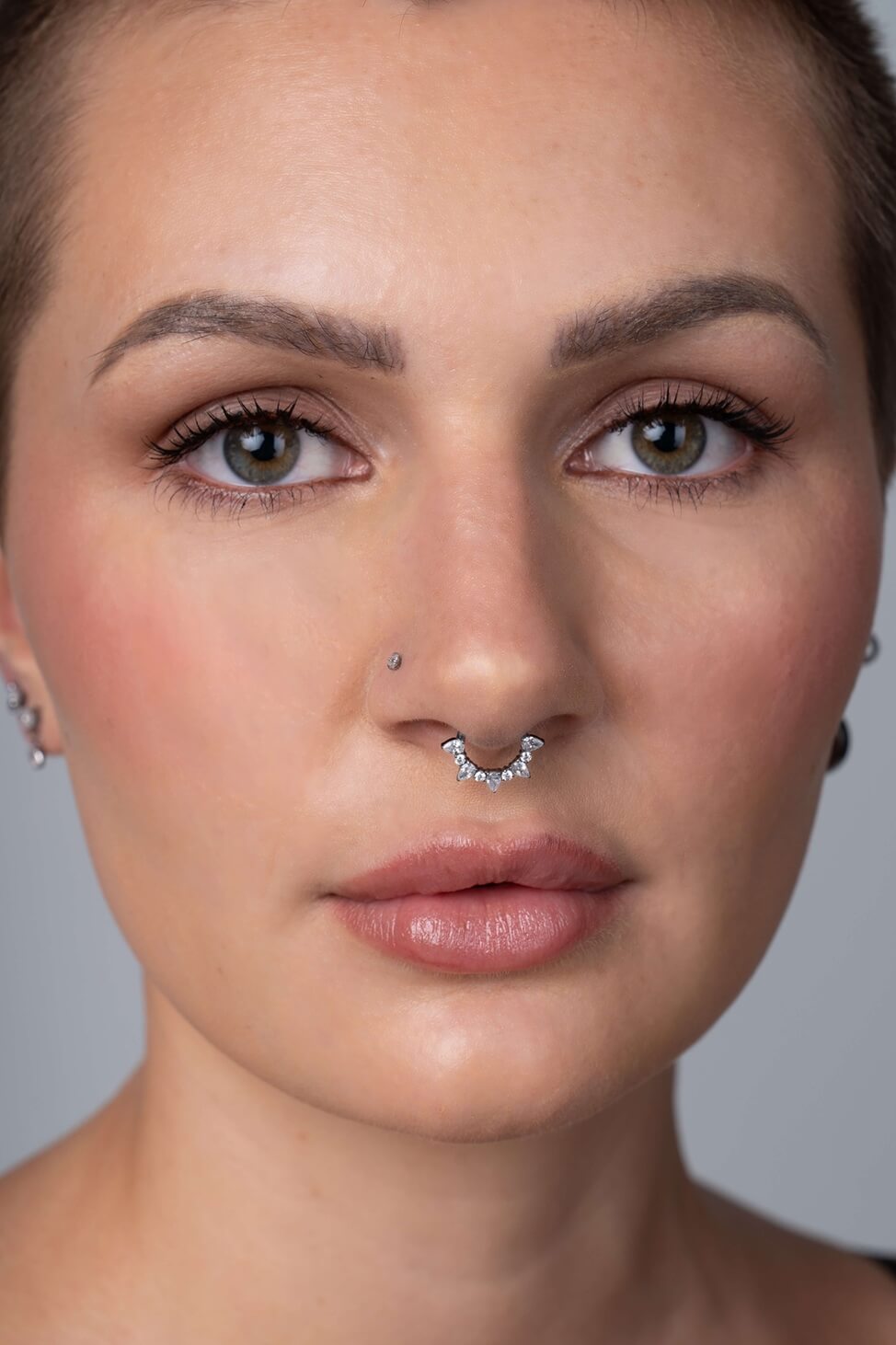
Dermal Piercings: what to expect, care tips and jewellery options.
Ready to really turn heads? A Dermal Piercing, also called a Microdermal Piercing is a bold way to decorate your skin with a floating gem or stud. Unlike your standard piercings (like ear and navel piercings), these beauties don’t need an entry and exit point – they’re anchored directly into your skin, giving the illusion that a gem or stud is floating on the surface of your body.
In this guide, we’ll walk you through all the fun (and important) details: from types of Dermal Piercings and how they’re done, to pain levels (don’t worry, we’ll look after you), healing time and the jewellery options you can choose from.
If you've ever wondered what it takes to rock this type of jewellery, buckle up – you’re about to get the lowdown on everything Dermal Piercings.
Types of Dermal Piercings
You can add a Dermal Piercing to pretty much any place on the body – as long as it’s an area of skin that’s deep enough to anchor the piercing into. Here are several options worth exploring.
- A Back Dermal Piercing can be placed in several spots on the back, including along the spine. A piercing on either side of the lower back is a popular pairing.
- A Dermal Piercing on the face gives you the opportunity to add a pop of jewellery on areas like the cheekbones or temples. Note: we don’t place dermals in the standard cheek/dimple location because movement from cheek muscles makes healing difficult. Placement along the cheekbone line (on flatter skin) is the suitable alternative.
- Chest Dermal Piercings are a bold choice, often placed on the sternum or collarbone to create a centrepiece of sparkle on the upper body.
- A Dermal Cheek Dimple Piercing is a playful way to highlight dimples and add accent to your smile. However, we don’t offer dermals in the actual standard cheek/dimple site due to muscle movement and healing challenges. Ask us about cheekbone-line placements instead.
- Dermal Piercings on the neck are often placed at the nape, creating an edgy, elegant look.
- A Thigh Dermal Piercing is an alternative but striking option for people who like to show off their legs.
- A Dermal Piercing on the décolletage brings a touch of elegance to the collarbone area. Positioned 1–2 cm away from the bone, it’s carefully placed to suit your skin type and elasticity for the best results.
- A calf piercing adds an unexpected touch to your legs, giving you a unique way to show your style with every step you take. The calf is relatively flat with thicker skin, which can be suitable.
- A wrist dermal is placed on the top side of the wrist about 1-2cm from the radius bone to avoid high movement areas
Got questions? We’ve got answers
Let’s get the lowdown on Dermal Piercings from what to expect during the procedure to aftercare, and everything in between.
How is a Dermal Piercing performed?
To create a Dermal Piercing, a small metal plate is placed just under the skin to anchor the piercing. A ball or jewel is screwed on top and then sits flat against the skin surface. This style of piercing can be done in most places on the body.
At SkinKandy, we use a 14-gauge anchor to pierce the skin and then a 14-gauge 4mm top or gem is screwed in to sit on the surface of the skin.
Is there a minimum age for a Dermal Piercing?
You can get a Dermal Piercing from the age of 16 with parental consent. Once you turn 18, no permission needed – you’re free to go for it! Just keep in mind, if you’re in Western Australia, you’ll need to wait until you’re 18 to get one without consent.
Are Dermal Piercings painful?
With most piercings, you can expect a bit of discomfort during the procedure, but how much depends on a few things. Generally, areas with more flesh tend to hurt less, so the placement of the piercing plays a factor.
The type of procedure and the skill of the piercer is also important, so be sure your piercer is skilled at this type of piercing (hello, SkinKandy team!). Your tolerance for pain is also a factor. If you have any concerns, chat to us before booking in. We can help reassure you and give you advice on the best placement for your anatomy and needs.
What about a Dermal Piercing healing time?
While every person is different, we find that full healing usually takes about six months. But remember, this is just a guide and will depend on a range of factors.
It’s a good idea to patch your Dermal Piercing (which is securing it with a Band-Aid) for the first three months. This is particularly important when you’re sleeping or working out, as it prevents your piercing getting bumped or damaged – you don’t want that!
What’s the best aftercare for a Dermal Piercing?
What if I get an infected Dermal Piercing?
No doubt you’ve heard stories about rejected or infected piercings. And it’s true, sometimes piercings don’t go to plan. That’s why it’s so important to get pierced by an experienced, qualified piercer in a sterile environment. And keep up with your aftercare – this stops bacteria from affecting your fresh piercing.
Dermal Piercing jewellery
Common metals used in dermal jewellery are titanium, anodised titanium and implant-grade stainless steel. While implant-grade stainless steel is the go-to for most body jewellery, it can sometimes irritate. So for sensitive skin types, titanium is the safest choice, as it’s the least likely to cause irritation.
So what are the jewellery options?
Anchor
Dermal piercings rely on a few key components to stay secure, starting with the dermal anchor. Anchors come in either flat-footed or rounded-base varieties, but we prefer flat-footed anchors because they’re angled to better grip the skin, making them nice and secure.
Top
The dermal top is the visible jewellery piece that screws onto the anchor, which has holes in the plate to help secure the piercing. It’s removable and interchangeable, though switching it out usually requires a visit to a piercer. For easier changes, some of our customers opt for magnetic tops. We have a range of tops from simple balls and cute shapes to colourful, multi-gem designs.
Ready to drop anchor?
A Dermal Piercing is a unique and eye-catching way to let your personality shine on almost any part of your body, from your face and neck to your ankles and back.
While this type of piercing sometimes requires extra care and consideration, its distinctive look is well worth it for those who love standing out. Ready to make it happen? Use our easy online booking form and see us at SkinKandy to make a statement.















